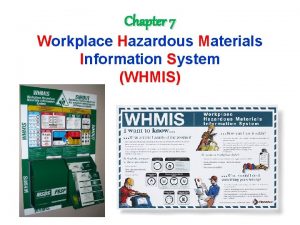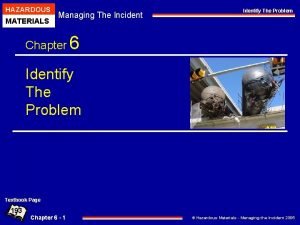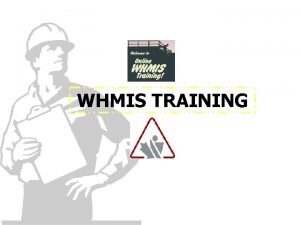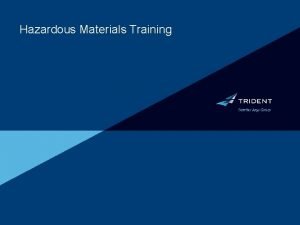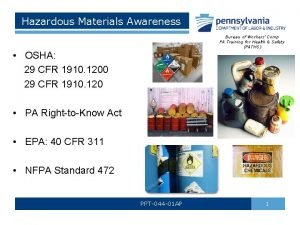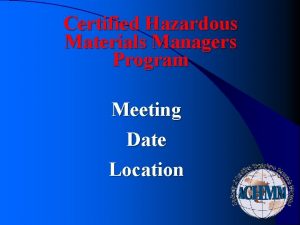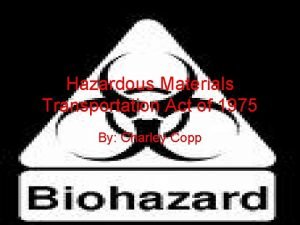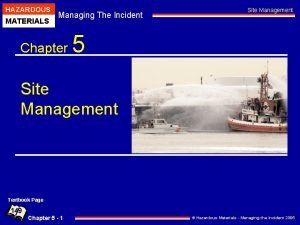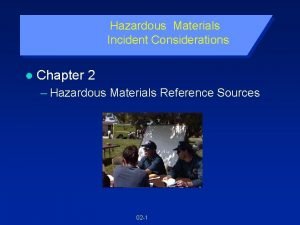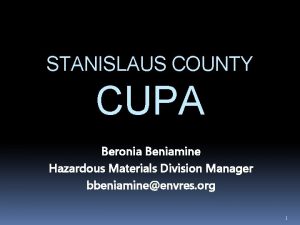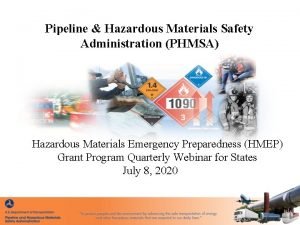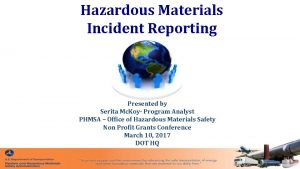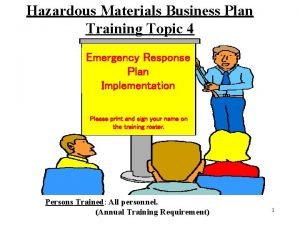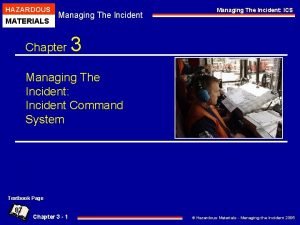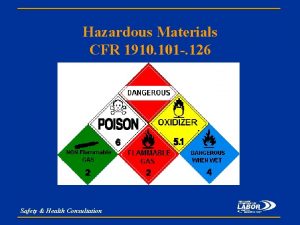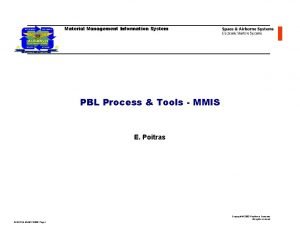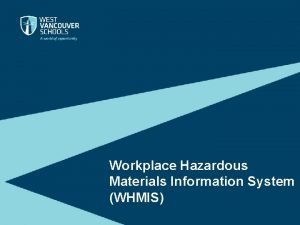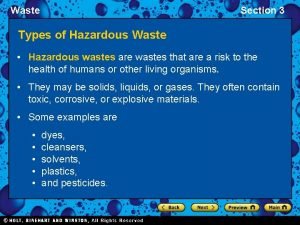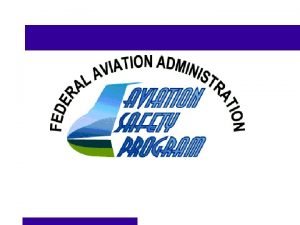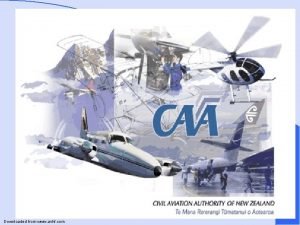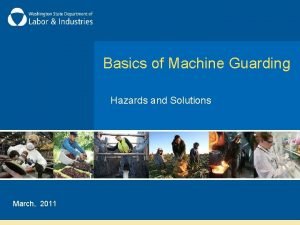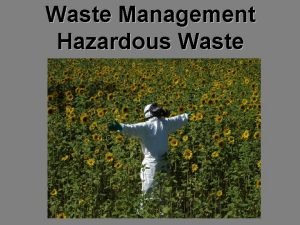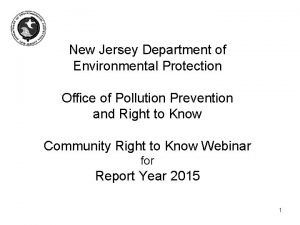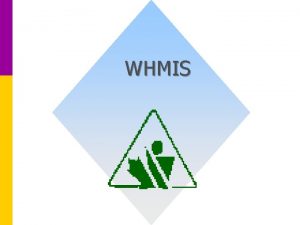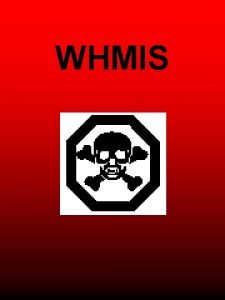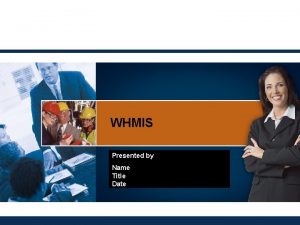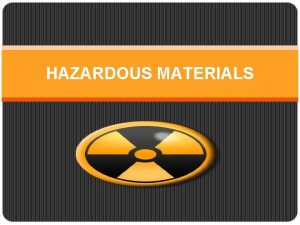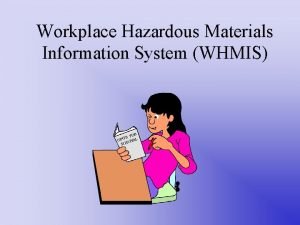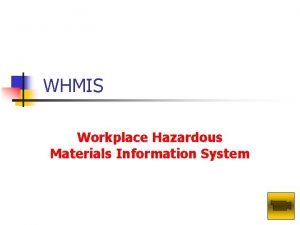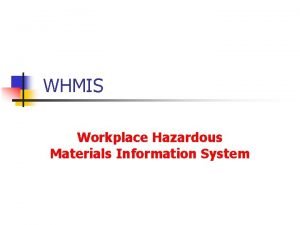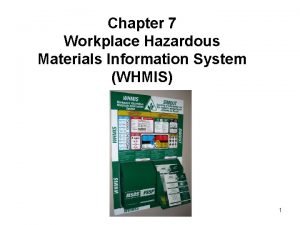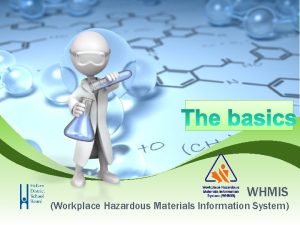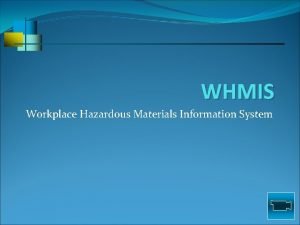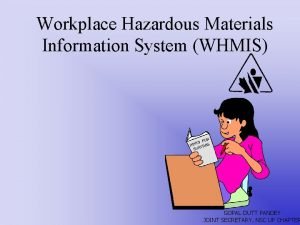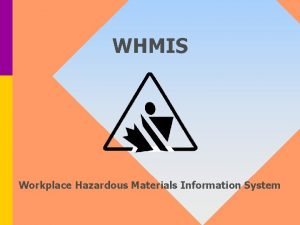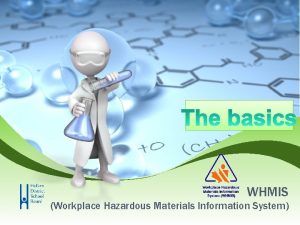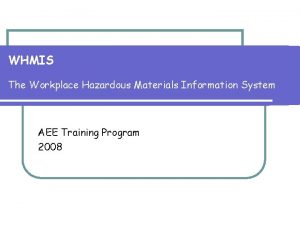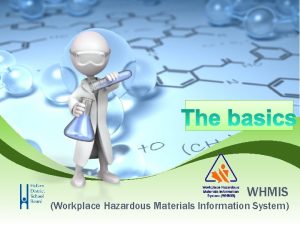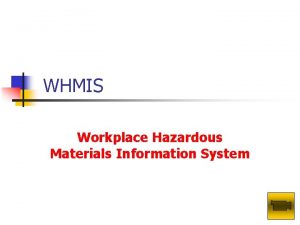Workplace Hazardous Materials Information System WHMIS What is































- Slides: 31

Workplace Hazardous Materials Information System (WHMIS)

What is WHMIS?

WHMIS was designed to address employers’ and workers’ right to know about the hazards and safe work practices related to certain chemicals and infectious biological substances. Materials that are subject to WHMIS legislation is called controlled products Requires employees to use products safely Requires the employer to ensure that employees are trained to use products safely and have access to information on safe use

Key Elements to WHMIS Identification : Labeling/Hazard Symbols Knowledge: Worker Education & Training Information: Material Safety Data Sheets

WHMIS Responsibilities Suppliers – – Determining which products are “controlled” products and classifying appropriately Establishing health and safety information regarding a product Labelling products with WHMIS labels Preparing and providing MSDS’s for customers and updating them Employers – – – Ensure all controlled products at the work sites have WHMIS labels Make MSDSs available and accessible to workers Train workers to read labels and MSDS’s, recognize WHMIS labels, how to handle, use and store controlled products and, if required, use personal protective equipment Employees – – Participate in education and training provided by the employer Follow prescribed safe work procedures

What is a Controlled Product? Controlled products are materials, products, or substances that meet any of the criteria for one or more of the six WHMIS Hazard Classes as defined in the Federal Controlled Product Regulation Exclusions The following are exempt from the suppliers responsibilities of WHMIS (no label or MSDS required): – – – Consumer retricted products Explosives Cosmetics, drug, food, or devices Pesticides, herbicides, and insecticides Radioactive material

WHMIS Hazard Symbols These hazard symbols on the label identify the product as controlled by WHMIS and classify the type of hazard. CLASS A Compressed Gas CLASS D-2 Poisonous and Infectious Material (material causing other toxic effects) CLASS B Flammable and Combustible Material CLASS D-3 Poisonous and Infectious Material (Biohazardous Infectious Material) CLASS C Oxidizing Materials CLASS E Corrosive Material CLASS D-1 Poisonous and Infectious Material (material causing immediate and serious effects) CLASS F Dangerously Reactive Material

Class A: Compressed Gas Characteristics – Gas inside cylinder is under pressure Hazards – Cylinder may explode if dropped or heated – Hazards associated with force of explosion and contents of cylinder Handling and Use – Transport with specialized cart – Use gas specific regulator – Store away from heat and fire sources – Test connections for leaks – Ensure cylinders are properly secured

Class B: Flammable and Combustible Characteristics – May burn or explode when exposed to heat, sparks, or flames Hazards – May ignite spontaneously – May ignite upon decomposing or being exposed to water Handling and Use – Store away from Class C: Oxidizing Materials – Avoid storing near sources of heat, sparks, or flames – Keep containers tightly sealed – Ground and bond when dispensing from 25 L containers – Store in flammable cabinets if quantities exceed 50 L – Transport using secondary containment

Class C: Oxidizing Material Characteristics – Can promote burning or explosions of other materials by providing an oxygen source for combustion Hazards – May burn skin and eyes on contact – Increase fire and explosion hazard – May cause combustibles to explode or react violently Handling and Use – Transport and store separately from flammables and organics – Store in non-corroding containers – Store away from sources of heat and ignition – Wear proper personal protective equipment Examples – Hydrogen peroxide – Bleach – Nitrates

Class D-1: Poisonous and Infectious Division 1: Materials causing immediate and serious toxic effects (acute) – Subdivision A: Very toxic material – Subdivision B: Toxic material Characteristics – Poisonous and potentially fatal materials resulting in immediate and severe harm Hazards – Small quantities may be harmful or lethal – May cause immediate death or serious harm if inhaled, swallowed, or absorbed through the skin Handling and Use – Avoid skin and eye contact – Minimize vapor exposure – Wear the recommended personal protective equipment – Wash hands after handling Examples – Cyanides – All halogens

Class D-2: Poisonous and Infectious Division 2: Materials causing other toxic effects (chronic, delayed) – Subdivision A: Very toxic material – Subdivision B: Toxic material Characteristics – Materials which have harmful effects after repeated exposures over long periods of time Hazards – May cause death or permanent injury – May cause organ damage, cancer, birth defects, or sterility – May lead to sensitization or allergies Handling and Use – Avoid skin and eye contact – Minimize vapor exposure – Wear the recommended personal protective equipment – Wash hands after handling Examples – Asbestos – Benzene

Class D-3: Poisonous and Infectious Division 3: Biohazardous infectious material Characteristics – Infectious agents or biological toxins resulting in serious disease or death Hazards – May cause serious disease resulting in illness or death Handling and Use – Work with materials in designated area (ie. Biosafety cabinet) – Disinfect area after cleaning – Wash hands after handling – Wear proper personal protective equipment Examples – E. Coli – Tissues – Viruses

Class E: Corrosive Material Characteristics – Materials that will erode metals or destroy tissues Hazards – Will burn human tissue upon contact – Can corrode laboratory materials, in particular metals Handling and Use – Store acids and bases separately – Store chemicals in non-corroding containers – When possible, work in a fume hood – Wear recommended personal protective equipment Examples – Strong acids and bases – Hydrogen Fluoride

Class F: Dangerously Reactive Characteristics – Materials may undergo unexpected reactions under certain conditions Hazards – May be chemically unstable – May vigorously polymerize – May react with water to release a toxic or flammable gas – May explode if exposed to heat or shock – May burn unexpectedly Handling and Use – Follow MSDS recommendations for storage and use – Wear recommended personal protective equipment – Examine storage containers frequently – Store and transport securely Examples – Azides – Hydrazine – Ether

Identification: Labels/Hazard Symbols Labels are the first identification to the user that a substance is a WHMIS controlled product. Labels must be: – Visible in normal conditions of storage – Easy to see – Durable – Attached in such a manner that they will remain in good condition The three types of labels in the WHMIS system are: – Supplier Label – Workplace Label – Other means of identification

Supplier Labels Must be attached by the supplier when the material arrives at the workplace to identify shipments that include controlled products Supplier labels must contain: 1. Product Identifier 2. Suppliers Identifier 3. Hazard Symbols 4. Risk Phrases 5. Precautionary Measures 6. First Aid Measures 7. MSDS Reference

Workplace Labels Workplace labels must be used when: – A controlled product is delivered to the workplace in bulk and a supplier label is not available – A controlled product is transferred to a smaller portable container for use in the workplace – The supplier label on the container becomes unreadable, damaged, or detached, and a replacement supplier label is not available Workplace labels need to show: – The product identifier – Safe handling procedures – Reference to an MSDS

What is MSDS? MSDS is an acronym for: Material Safety Data Sheet must be obtained at the time of purchase A MSDS must be less than 3 years old MSDS's must be available for use and reference at all times MSDS provides information on: – health effects of overexposure – health evaluation related to product handling, storage and use – measures to protect workers at risk of overexposure – emergency procedures

MSDS The MSDS must contain the following sections and information: – Section 1: Product identification and use – Section 2: Hazardous ingredients – Section 3: Physical data – Section 4: Fire and explosive data – Section 5: Reactivity data – Section 6: Toxicology properties – Section 7: Preventative measure – Section 8: First Aid measures – Section 9: Preparation date

MSDS FETCH West Vancouver School District utilize the computerized WHMIS system known as MSDS FETCH contains over 10, 000 MSDS that can be accessed in a few minutes by phone, fax and online How to access MSDS FETCH – It is available to members 24 hours a day, 7 days a week – Website: http: //msdsfetch. vsb. bc. ca • Login: sd 45 westvan • Password: 6047313492 – Call 604 -713 -5273 office hours M-F 8: 30 am to 4: 30 pm

WHMIS 2015 In February 2015, Canada amended the Hazardous Products Act and published the Hazardous Products Regulations in order to incorporate the GHS into WHMIS To allow time for suppliers, employers and workers to adjust, implementation will take place over a multi-year transition period where both WHMIS (WHMIS 1988) and WHMIS 2015 may be used in the workplace

WHMIS 2015 – What are the Changes? WHMIS has aligned with the Globally Harmonized System of Classification and Labelling of Chemicals (GHS) and the goal is to have a common set of rules used worldwide Aligning WHMIS with GHS helps to: – – – Enhance the protection of worker health and safety by having improved and consistent hazard information Encourage safe transport, handling, and use of hazardous products Promote better emergency response Promote regulatory efficiency and compliance Facilitate international trade GHS will not replace WHMIS, however, will create some important changes to WHMIS New classification rules and hazard classes A standardized format for Safety Data Sheets (formerly MSDS) New hazard pictograms New label requirements

Hazard Group WHMIS 2015 applies to two major groups of hazards: physical, and health. Each hazard group includes hazard classes that have specific hazardous properties. – Physical hazards group: based on the physical or chemical properties of the product - such as flammability, reactivity, or corrosivity to metals – Health hazards group: based on the ability of the product to cause a health effect - such as eye irritation, respiratory sensitization (may cause allergy or asthma symptoms or breathing difficulties if inhaled), or carcinogenicity (may cause cancer)

Hazard Class and Category Hazard classes are a way of grouping together products that have similar properties. Most of the hazard classes are common to GHS and will be used worldwide by all countries that have adopted GHS. Some hazard classes are specific to WHMIS 2015 Each hazard class contains at least one category. The hazard categories are assigned a number (e. g. , 1, 2, etc. ) Categories may also be called "types". Types are assigned an alphabetical letter (e. g. , A, B, etc. ). In a few cases, sub-categories are also specified. Subcategories are identified with a number and a letter (e. g. , 1 A and 1 B) Some hazard classes have only one category (e. g. , corrosive to metals), others may have two categories (e. g. , carcinogenicity (cancer)) or three categories (e. g. , oxidizing liquids). There a few hazard classes with five or more categories (e. g. , organic peroxides) The category tells you about how hazardous the product is (that is, the severity of hazard) Category 1 is always the greatest level of hazard. If Category 1 is further divided, Category 1 A within the same hazard class is a greater hazard than category 1 B

GHS Pictograms Flammables (gases, aerosols, liquids, solids) Self-reactive substances and mixtures Pyrophoric liquids, solids, and gases Self-heating substances and mixtures Substances and mixtures that in contact with water emit flammable gas Organic peroxides Skin sensitization Acute toxicity (harmful) Specific target organ toxicity – single exposure (category 3) Eye irritation Skin irritation Hazardous to the ozone layer Acute toxicity (severe) Carcinogenicity Respiratory sensitization Reproductive toxicity Specific target organ toxicity – repeated exposure Specific target organ toxicity – single exposure (category 1, 2) Aspiration hazard Germ cell mutagenicity Corrosive to metals Serious eye damage Skin corrosion Gases under pressure Oxidizing gases, liquids, solids Biohazardous infectious material Self-reactive substances and mixtures Organic peroxides Explosives Hazardous to the aquatic environment Canada will not be implementing

Safety Data Sheets (SDS) Updated terminology for the MSDS Will consist of 16 sections and variable number of pages Will not need to be updated every 3 years Must be current at time of sale/import Section 1 2 3 4 5 6 7 8 9 10 11 12 -15 16 Hazardous Product Regulations Heading Identification Hazard identification (including classification and label text) Composition/information on ingredients First-aid measures Fire-fighting measures Accidental release measures Handling and storage Exposure controls/personal protection Physical and chemical properties Stability and reactivity Toxicological information Ecological, transport and regulatory information, disposal considerations Other information

Safety Data Sheets (SDS) • Remember the four basic questions that the SDS should answer • • Identify of the product and supplier? Hazards of the product? Precautions you should take? What to do in an emergency? • Click here for an example • Safety Data Sheets

Labels An example of a supplier’s label • Suppliers Labels will require the following: • • The pictogram, signal word, and hazard statement are to be grouped together To be clearly and prominently displayed on the container To be easy to read, and To be in contrast with other information on the product or container • Workplace Labels will require the following: • • • Product name Safe handling precautions, may include pictogram or other supplier label information Reference to the SDS (if available)

Label Requirements – Comparison

Questions? Contact Human Resources at 604 -9811000 or visit us at the School Board Office
 Define whmis
Define whmis Us military marking system for hazardous materials
Us military marking system for hazardous materials Whmis workplace label
Whmis workplace label Dot
Dot Hazardous materials table
Hazardous materials table Hazwoper
Hazwoper Chmm accreditation training
Chmm accreditation training Hazardous materials transportation act of 1975
Hazardous materials transportation act of 1975 Hazardous materials managing the incident
Hazardous materials managing the incident Hazardous materials reference books
Hazardous materials reference books Stanislaus county hazardous waste
Stanislaus county hazardous waste Pipeline and hazardous materials administration
Pipeline and hazardous materials administration Hazardous materials incident report
Hazardous materials incident report Hazardous materials business plan
Hazardous materials business plan Hazardous materials managing the incident
Hazardous materials managing the incident 29 cfr 1910 hazardous materials
29 cfr 1910 hazardous materials What is material information system
What is material information system What does sds stand for whmis
What does sds stand for whmis Favourite cars
Favourite cars Household materials harmful and useful
Household materials harmful and useful Natural man made
Natural man made What is adopting materials
What is adopting materials Direct materials budget with multiple materials
Direct materials budget with multiple materials Section 3 hazardous waste answers
Section 3 hazardous waste answers Aviation hazardous attitudes
Aviation hazardous attitudes Color coding for waste disposal
Color coding for waste disposal Avhf
Avhf 5 hazardous attitudes
5 hazardous attitudes Transverse motion machines
Transverse motion machines Msw apes
Msw apes What is toxic waste
What is toxic waste Nj crtk environmental hazardous substances
Nj crtk environmental hazardous substances
